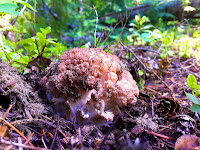THEY LOOK LIKE something from the deep, or even outer space. Coral mushrooms are a family (Clavariaceae) of multi-colored fungi that resemble the sort of undersea coral you might find while snorkeling in warm equatorial waters. There are many species across North America, and they can grow quite large.

In my region the popular edible varieties tend to be spring mushrooms, in particular the pink-tipped coral Ramaria botrytis. Another is the yellow coral, both Ramaria rasilispora and Ramaria magnipes.
These are large, meaty mushrooms with a stout, fleshy base (especially R. magnipes, which is also called bigfoot). Both yellow and pink corals begin to emerge after morels and in advance of the spring porcini flush in the Pacific Northwest, and given good conditions they’ll continue to fruit throughout the summer and into fall in some locales. Fortunately, these are the dominant species where I pick spring porcini, and I’ll find the mushrooms cohabiting, but harvesters should learn the particulars of their own patches.
Look for corals that have just emerged from the duff and leaf litter. As they grow, the tips elongate and continue to trap all manner of forest debris in their clutches, making them a chore to clean. I look for tightly clustered corals that resemble cauliflower more than weird sea creatures.

I picked some corals the other day while scouting spring porcini. When I got them home I decided to try to keep their cool looking profiles intact by slicing up for tempura. The porcini went into the mix as well, along with other assorted veggies and shrimp. Use your favorite tempura recipe; I like this one.



that looks delicious! thanks for the great post.
I LOVE tempura and out of found foraged food makes it all the more delicious! What a lovely post and most interesting to boot. Cheers. 🙂
Hi,
I read your blog a lot and love your book. I like reading about your mushroom finds, but it’s driving me crazy!
I have had no luck finding spring porcini, and found a grand total of four morels this year. Today I went down 97 and drove up various forest service roads, like 7324
and 9716. Elevation where I was walking is about 4000. The trees are mostly pine. The ground seems very dry.
Am I even in the right general location? Any pointers appreciated. Cheers,
Branden – Mostly pine means you’re probably on south facing slopes. Too dry. Try the north facing slopes and look for more mixed conifers. As for, porcini, they’ve been slow to flush, so there’s still time. Keep at it!
Thanks for the info, Langdon
I tried again up on 97 at about 4500 ft
Found quite a few newly flushed morels, quite a few coral mushrooms, and surprisingly, many russulas. Mostly the large white (probably brevipes) but many with a purplish tinge, too.
No porcini, though. I thought maybe I was too high up – maybe I’ll wait a week and check those spots again.
Cheers
FYI – I received a message from Sam Schaperow reminding readers that there is a deadly coral in Japan that could conceivably hitch a ride to North America the way the non-native Death Cap (Amanita phalloides) did. Here’s more on it.